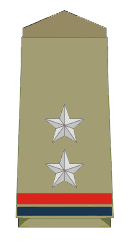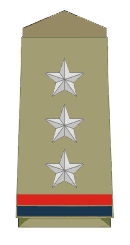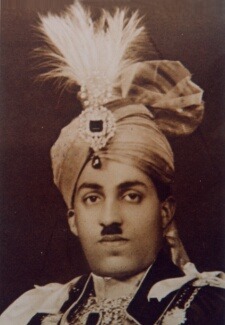|
Sub-inspector
Sub-inspector (SI), or sub-inspector of police or police sub-inspector (PSI), is a rank used extensively in South Asia: in the police forces of Bangladesh, Pakistan, India, and Sri Lanka, which are primarily based on the British model. It was formerly used in most British colonial police forces and in certain British police forces as well. The rank usually was in charge of a police substation or assisted an inspector. United Kingdom The rank of sub-inspector was introduced into the Metropolitan Police in the late 19th century. It did not last long, being effectively replaced by station sergeant in 1890. Officers who already held the rank retained it, and were promoted to inspector as soon as a vacancy arose. In the Metropolitan Police, a rank wearing one star was formerly officially known as a " station inspector" to distinguish it from the more senior rank of sub-divisional inspector that was abolished in 1949. Canada The Royal Canadian Mounted Police rank of sub-inspecto ... [...More Info...] [...Related Items...] OR: [Wikipedia] [Google] [Baidu] |
Inspector Of Police
Inspector, also police inspector or inspector of police, is a police rank. The rank or position varies in seniority depending on the organization that uses it. Australia The rank of Inspector is present in all Australian police forces except for the Northern Territory. Where it exists, it is generally the next senior rank from Senior Sergeant, and is the lowest commissioned rank. Uniformed officers of this rank wear epaulettes with three pips, matching a Captain in the army. In addition to the general rank of inspector, some police forces use other ranks such as detective inspector and district inspector. Austria In Austria a similar scheme was used as in Germany. At some point the police inspector was completely removed from the list of service ranks. The current police service has an inspectors service track with ''Inspektor'' being the entry level – it is followed by ''Revierinspektor'' (precinct inspector), ''Gruppeninspektor'' (group inspector), ''Bezirksinspektor' ... [...More Info...] [...Related Items...] OR: [Wikipedia] [Google] [Baidu] |
Assistant Sub-inspector Of Police
In the police forces of India and Nepal, an Assistant of sub-inspector (ASI) is a non-gazetted police officer ranking above a police head constable and below a Sub-inspector. The rank insignia for an ASI is one star, with a red and blue striped ribbon at the outer edge of the shoulder straps. He/she can be an Investigating officer. A.S.I. is often the officer in charge of Police Outposts or "phari" and Investigation Centres. Some police stations carry incharge of GD duty. They make reports of incidents for senior officers. In Police Stations ASI are usually in charge of armouries and in training centres they are the Chief Drill Officer. In Armed Police and CRPF/BSF/ITBP/CISF they are Platoon second in charge after the SI (Sub-inspector Sub-inspector (SI), or sub-inspector of police or police sub-inspector (PSI), is a rank used extensively in South Asia: in the police forces of Bangladesh, Pakistan, India, and Sri Lanka, which are primarily based on the British model. It was f ... [...More Info...] [...Related Items...] OR: [Wikipedia] [Google] [Baidu] |
Central Bureau Of Investigation
The Central Bureau of Investigation (CBI) is the domestic crime investigating agency of India. It operates under the jurisdiction of the Ministry of Personnel, Public Grievances and Pensions. Originally set up to investigate bribery and governmental corruption, in 1965 it received expanded jurisdiction to investigate breaches of central laws enforceable by the Government of India, multi-state organised crime, multi-agency or international cases. CBI is exempted from the provisions of the Right to Information Act. CBI is India's officially designated single point of contact to act as the liaison with Interpol. The CBI headquarter is located in CGO Complex, near Jawaharlal Nehru Stadium in New Delhi. History Special Police Establishment The Bureau of Investigation traces its origins to the Special Police Establishment (SPE), a Central Government Police force, which was set up in 1941 by the Government of India to investigate bribery and corruption in transactions with the ... [...More Info...] [...Related Items...] OR: [Wikipedia] [Google] [Baidu] |
Central Reserve Police Force
The Central Reserve Police Force (CRPF) is a central armed police force in India under the Ministry of Home Affairs. The CRPF assists states and Union Territories in maintaining law and order and internal security. It is composed of the Central Reserve Police Force ( Regular) and Central Reserve Police Force (Auxiliary). It was established on 27 July 1939 as Crown Representative's Police with the objective of providing security to the British Crown Representatives in India. The force was later renamed as the Central Reserve Police Force by an Act of Parliament in 1949. The CRPF played a major role in the Parliamentary elections of September 1999. The Central Reserve Police Force (CRPF) is the largest central armed police force in India, comprising 247 battalions and exceeding a total strength of 301,376 personnel, as of 2019. CRPF officers are also deployed in United Nations missions. History Originally constituted as the Crown Representative Police in 1939, CRP was raised ... [...More Info...] [...Related Items...] OR: [Wikipedia] [Google] [Baidu] |
Border Security Force
The Border Security Force (BSF) is a central armed police force in India under the Ministry of Home Affairs. It is responsible for guarding India’s borders with Pakistan and Bangladesh. It was formed in the wake of the Indo-Pak War of 1965 to ensure the security of India’s borders and for related matters. The BSF has grown from 25 battalions in 1965, to 193 battalions with a sanctioned strength of 270,000 personnel including an expanding air wing, water wing, an artillery regiment and specialised units. It is currently the world's largest border security force. BSF has been termed the ''First Line of Defence'' of Indian territories. History Since India's independence in 1947, the protection of its international boundaries was the responsibility of the local police in each border state, with little inter-state coordination. However, during the Indo-Pakistani War of 1965, Pakistan attacked Sardar Post, Char Bet, and Beria Bet on April 9, 1965, in Kutch. This attack ... [...More Info...] [...Related Items...] OR: [Wikipedia] [Google] [Baidu] |
Kerala
Kerala ( , ) is a States and union territories of India, state on the Malabar Coast of India. It was formed on 1 November 1956, following the passage of the States Reorganisation Act, by combining Malayalam-speaking regions of the erstwhile regions of Kingdom of Cochin, Cochin, Malabar District, Malabar, South Canara, and Travancore. Spread over , Kerala is the 14th List of states and union territories of India by area, smallest Indian state by area. It is bordered by Karnataka to the north and northeast, Tamil Nadu to the east and south, and the Laccadive Sea, Lakshadweep Sea to the west. With 33 million inhabitants as per the 2011 Census of India, 2011 census, Kerala is the List of states of India by population, 13th-largest Indian state by population. It is divided into 14 List of districts of Kerala, districts with the capital being Thiruvananthapuram. Malayalam is the most widely spoken language and is also the official language of the state. The Chera dynasty was the f ... [...More Info...] [...Related Items...] OR: [Wikipedia] [Google] [Baidu] |
Naib Subedar
Nawab is a royal title indicating a ruler, often of a South Asian state, in many ways comparable to the Western title of Prince. The relationship of a Nawab to the Emperor of India has been compared to that of the Kings of Saxony to the German Emperor. In earlier times the title was ratified and bestowed by the reigning Mughal emperor to semi-autonomous Muslim rulers of subdivisions or princely states in the Indian subcontinent loyal to the Mughal Empire, for example the Nawabs of Bengal. "Nawab" usually refers to males and literally means ''Viceroy''; the female equivalent is "Begum" or "''Nawab Begum''". The primary duty of a Nawab was to uphold the sovereignty of the Mughal emperor along with the administration of a certain province. The title of "nawabi" was also awarded as a personal distinction by the paramount power, similar to a British peerage, to persons and families who ruled a princely state for various services to the Government of India. In some cases, the t ... [...More Info...] [...Related Items...] OR: [Wikipedia] [Google] [Baidu] |
Indian Army
The Indian Army (IA) (ISO 15919, ISO: ) is the Land warfare, land-based branch and largest component of the Indian Armed Forces. The President of India is the Commander-in-Chief, Supreme Commander of the Indian Army, and its professional head is the Chief of the Army Staff (India), Chief of the Army Staff (COAS). The British Indian Army, Indian Army was established on 1 April 1895 alongside the long established presidency armies of the East India Company, which too were absorbed into it in 1903. Some princely states maintained their own armies which formed the Imperial Service Troops which, along with the Indian Army formed the land component of the Armed Forces of the Crown of India, responsible for the defence of the Indian Empire. The Imperial Service Troops were merged into the Indian Army after Independence of India, independence. The units and regiments of the Indian Army have diverse histories and have participated in several battles and campaigns around the world, earnin ... [...More Info...] [...Related Items...] OR: [Wikipedia] [Google] [Baidu] |
Subedar
Subedar ( ) is a military rank in the militaries of South Asia roughly equivalent to that of a warrant officer. Historically classed in the British Indian Army as a Viceroy's commissioned officer, the rank was retained in the Indian Army and Pakistan Army after independence. The rank of subedar is classed as a junior commissioned officer rank in India and Pakistan. History ''Subedar'' or ''subadar'' was the second-highest rank of Indian officers in the military forces of British India, ranking below "British Commissioned Officers" and above "Local Non-Commissioned Officers". Indian officers were promoted to this rank on the basis of both lengths of service and individual merit. Under British rule, a Risaldar was the cavalry equivalent of a Subedar. Subedar and Risaldar were both ranked senior to a Jemadar and junior to a Subedar Major or a Risaldar Major in an infantry/cavalry regiment of the Indian Army. Both Subedars and Risaldars wore two stars as rank insignia. The ... [...More Info...] [...Related Items...] OR: [Wikipedia] [Google] [Baidu] |





